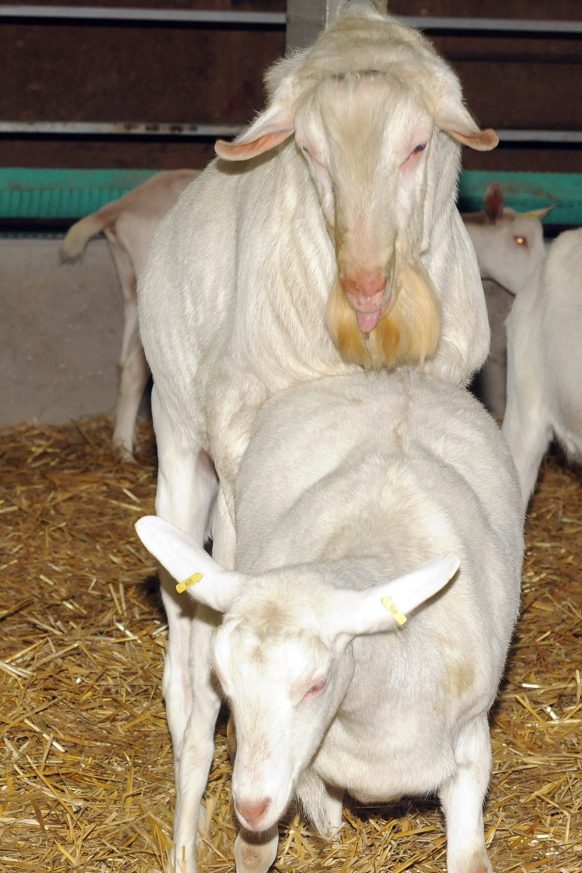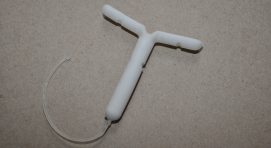For both meat and dairy operations, successful breeding is of critical importance to the farm’s production; in fact, no production will occur without it. However, the demand for goat meat and milk throughout the year doesn’t always coincide with the natural breeding and kidding cycle of goats in Ontario.
Goats are seasonal breeders that can be manipulated to breed out of season. Managing timing and intensity of breeding allows producers to take better advantage of the best marketing opportunities in both meat and milk sectors.
In order for any breeding program to be successful, good nutrition, veterinary care, management, and environmental conditions must be provided to the goats. Knowledge of goat reproduction and a relationship with your herd veterinarian are also essential to breeding success. Finally, be prepared to address challenges that may arise during breeding, gestation (pregnancy), kidding, and raising kids.
Natural breeding
 Bucks will naturally come into rut (become ready for breeding and attempt to attract does) and does will naturally cycle (come into heat and be receptive to breeding) as the days get shorter. In Ontario, this is approximately from mid-August to March, resulting in kidding from approximately January to August. Breeding from April to August is considered out-of-season.
Bucks will naturally come into rut (become ready for breeding and attempt to attract does) and does will naturally cycle (come into heat and be receptive to breeding) as the days get shorter. In Ontario, this is approximately from mid-August to March, resulting in kidding from approximately January to August. Breeding from April to August is considered out-of-season.
Natural breeding allows for one kidding period per year, which reduces workload and results in kids of similar ages and weights, which can simplify kid management and meat kid marketing. However, for dairy operations, this means many does will reach their dry period at approximately the same time, creating periods where little or no milk is produced on the farm. Additionally, meat goats on a natural breeding program will often not be ready at major market peaks, causing a loss of potential revenue. Therefore, natural breeding can cause income to fluctuate throughout the year.
Some producers will leave bucks and does together throughout the year in hopes that some successful breeding will occur out-of-season. This creates some availability of milk and meat goats for various holidays, but increases labour, as kidding may occur year round and kidding dates can be hard to estimate. Further, selling and shipping meat kids becomes less economical, as shipping kids at the correct market weight may require many trips with small groups of kids or kids may be shipped in larger groups with a wider weight range, reducing potential revenue.
Extended lactation
Dairy producers can create a more stable year-round milk supply by not rebreeding does and not drying them off, creating an extended lactation. This will allow producers to milk the doe longer than the average 305 day lactation, but the boost in milk production seen after kidding will only occur once, before stabilizing at a lower level of production for the rest of the lactation. Further, some does may spontaneously dry off on this management system. Extended lactations also reduce the number of kids born on the farm. This can be positive, by reducing the workload associated with kidding, or negative, by reducing available replacement does that can join the milking herd, replace cull does, or be sold for additional income.
Some producers will rebreed does and not dry them off before kidding. This can create a year round milk supply but also increases the risk of mastitis and decreases colostrum quality, among other negative health outcomes for both the doe and kids.
Extended natural breeding or accelerated breeding
Extended natural breeding lengthens the natural breeding season by manipulating lighting and/or using hormone treatments to create a kidding season of seven to eight months per year. With accelerated breeding, it is possible to initiate cycling more frequently, allowing three kiddings per doe over two years. Both extended natural breeding and accelerated breeding can be achieved by carefully managing nutrition and lighting, removing kids from does, and the use of hormones.
These programs can help create a more consistent supply of kids, which leads to a more consistent milk supply in dairy herds and gives meat goat producers the ability to market kids in advance of major holidays, leading to increased profitability. Additionally, kidding can be planned around feed or labour availability, further allowing producers to control costs while optimizing their production for various seasons. Kidding over such a long period can become tiring for animal caretakers, so additional staff to care for close up does, fresh does, and kids may be needed depending on herd size. It is important to note that programs that manipulate the natural breeding season have varied levels of success, and reduced fertility may be expected. However, does that were bred out-of-season should produce kids more likely to successfully breed out-of-season.
The buck effect – Suddenly introducing a buck to does that have been out of sight and smell of bucks for at least three weeks is a common approach to induce cycling. This is a fairly unreliable method when used alone, but can be helpful if used along with other approaches.
Lighting
For extended natural breeding or accelerated breeding, sexually mature does and bucks should be housed separately and exposed to at least 18 hours of light for a period of 40 to 50 days. Dark periods must be completely dark, with no natural or artificial light (even a very small amount of light can disrupt this program and prevent goats from cycling on schedule). After this period, daylight exposure is shortened to ten hours of light per day for forty days. This mimics shorter days and causes does and bucks to begin cycling. This program can increase energy bills and may require management changes to create buck housing out of sight and smell of does as well as reduce light entering goat housing from artificial light outside (such as security lighting) during the dark period and to prevent goats from accessing dark areas during the light period.
Hormones
Hormones can be used to bring does into heat as well. Hormones are used to replicate the natural cycle of the doe. A Controlled Internal Drug Releasing Device (CIDR) can be used in conjunction with injections of hormones to begin a heat cycle.
An example CIDR protocol is:
Day 1 – Place CIDR
Day 12 – Inject prostaglandin
Day 14 – Remove CIDR and inject pregnant mare’s serum gonadotropin (PMSG)
Day 15 – Introduce a buck in a nearby pen
Day 16 – Breed 43 hours after the CIDR is removed
Caution: hormones are not approved for use in goats. Always consult your herd veterinarian before use.
There are a variety of other hormones and protocols that can be used to modify the doe’s reproductive cycle, including feed additives. It is important to remember that hormones are used off-label for goats, so producers must have a prescription from the herd veterinarian in order to use these protocols[1]. As the products are off-label, milk and meat withdrawals are not known for many of these products. Your herd veterinarian can determine safe withdrawal times as well as correct dosages and protocols for your herd.
Summary
The breeding strategy that works best for you and your herd will depend on many factors, including market demands, management system, preferred kidding period, and willingness to invest time and money in reproductive technologies. Your herd veterinarian is an essential component to establishing successful breeding program. Always consult your veterinarian when considering a new breeding strategy.
To read more about breeding management strategies, contact the office to order Ontario Goat’s “Goat Reproduction” and “Best Management Practices for Commercial Goat Production.”
[1] See Ontario Goat’s “Extra Label Drug Use in Goat Production” factsheet for more information.
